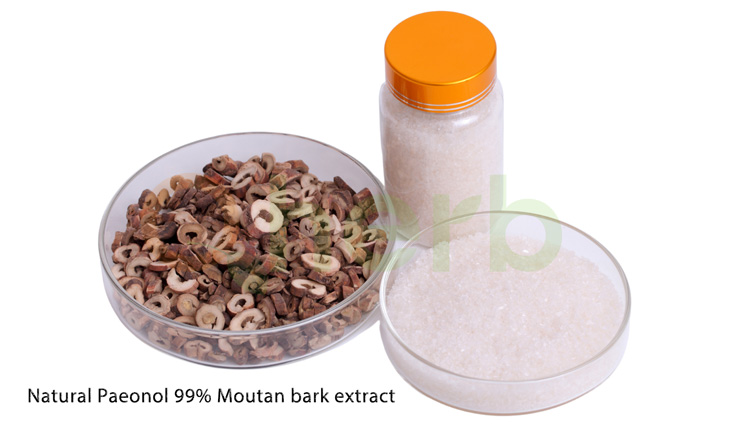Paeonol is a natural compound with various pharmacological effects, including anti-inflammatory, analgesic, and antioxidant properties. It is widely used in pharmaceuticals, cosmetics, and health supplements. Paeonol can be extracted from plants like tree peony bark (Moutan Cortex) and Cynanchum paniculatum, or synthesized chemically. But what are the key differences between natural and synthetic paeonol? Which one is better for your needs? This article compares them in terms of sources, production methods, purity, cost, and applications.

- Sources and Production Methods
(1) Natural Paeonol
- Source: Extracted from medicinal plants like peony root bark (Moutan Cortex), Paeonia lactiflora, and Cynanchum paniculatum.
- Extraction Process: Uses solvents (ethanol, water), followed by purification steps like column chromatography and crystallization.
- Characteristics: Relies on plant cultivation, has a longer production cycle, but aligns with traditional medicine principles.
(2) Synthetic Paeonol
- Source: Derived from petrochemical products (e.g., resorcinol, p-hydroxybenzoic acid) via organic synthesis.
- Production Process: Chemical reactions (e.g., Friedel-Crafts acylation), followed by purification to obtain high-purity paeonol.
- Characteristics: Shorter production time, suitable for large-scale industrial production, and more cost-effective.
✅ Key Difference: Natural paeonol depends on plant resources, while synthetic paeonol relies on chemical synthesis, offering higher efficiency.
- Composition and Purity Comparison
| Aspect | Natural Paeonol | Synthetic Paeonol |
| Main Components | Paeonol + co-extracted compounds (e.g., flavonoids, glycosides) | High-purity paeonol (typically ≥98%) |
| Impurities | May contain tannins, pigments | May contain synthetic intermediates or catalyst residues |
| Bioactivity | Multi-component synergy, gentler effects | Single compound, precise but may lack synergistic effects |
✅ Key Difference: Natural paeonol may offer broader bioactivity, while synthetic paeonol is more standardized for pharmaceutical use.
- Cost and Environmental Impact
- Natural Paeonol:
- Higher cost (due to plant cultivation and extraction inefficiency).
- More eco-friendly (but solvent recovery must be managed).
- Synthetic Paeonol:
- Lower cost (industrial production is more efficient).
- Environmental concerns (may involve toxic reagents and waste disposal).
✅ Key Difference: Synthetic paeonol is more economical, but natural paeonol aligns better with green consumer trends.
- Applications and Market Acceptance
(1) Pharmaceuticals & Supplements
- Natural Paeonol: Preferred in traditional medicine and natural health products.
- Synthetic Paeonol: Used in standardized drugs (e.g., anti-inflammatory or cardiovascular medications).
(2) Cosmetics
- Natural Paeonol: Used in high-end skincare (marketed as “plant-derived”).
- Synthetic Paeonol: Common in mass-market products for anti-allergy and antioxidant benefits.
(3) Regulatory Standards
- Natural extracts must comply with heavy metal and pesticide residue limits.
- Synthetic versions must meet chemical purity (e.g., ICH guidelines) and solvent residue regulations.
- How to Choose?
- Choose Natural Paeonol if:
- You need traditional medicine formulations, premium cosmetics, or “natural” branding.
- Choose Synthetic Paeonol if:
- You require high purity, low cost, and large-scale production for pharmaceuticals or cosmetics.
Conclusion
Both natural and synthetic paeonol have pros and cons, and the choice depends on cost, efficacy needs, and market positioning. Natural extracts are ideal for traditional medicine and high-end markets, while synthetic paeonol dominates in standardized drugs and mass-market products. In the future, bio-synthesized paeonol (e.g., microbial fermentation) may emerge as a sustainable alternative!







